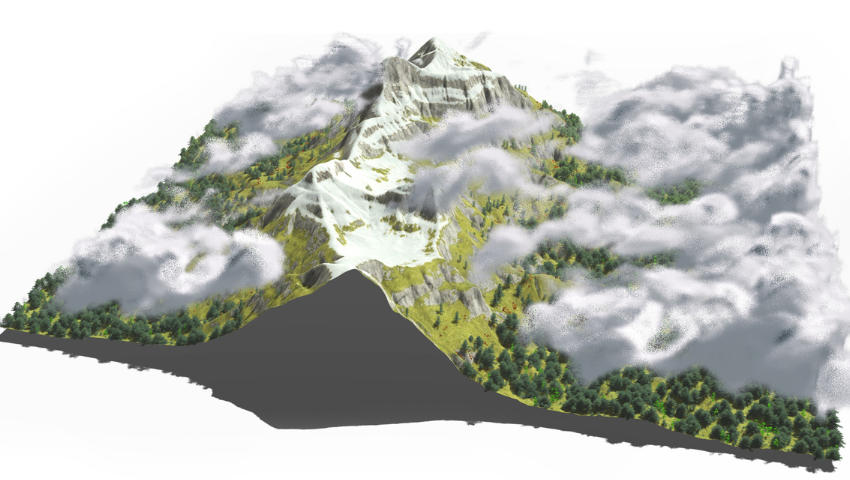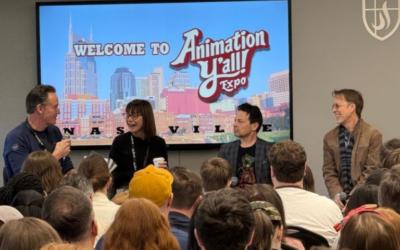© Sören Pirk
In this career profile, we sit down with longtime SIGGRAPH contributor and participant Sören Pirk. Get to know Pirk and his career story, which includes work at Google and Adobe Research, and get to know his research interests, which include visual computing, machine learning, and environmental modeling.
SIGGRAPH: Tell us about you and your career to date. What brought you to Adobe Research? What led you to focus your research on visual computing and machine learning?
I was always interested in getting to the bottom of things and developing an understanding of how technology works and how it can be useful. I graduated from a German university of applied sciences. As part of finishing my master thesis there, I spent almost a year at the Human Interface Technology Lab in New Zealand (HITLabNZ). This was in 2007, and even back then people in the HITLabNZ already worked on augmented reality applications and all sorts of interesting interface technologies. I coincidentally met the director of the lab, Prof. Dr. Mark Billinghurst, at a technology fair in Germany. Mark invited me to work on a research project with him. I was immediately fascinated by all the great research that students and researchers were working on in the lab, and I was thrilled to spend some time in New Zealand. Working with Mark at the HITLabNZ immediately sparked the idea to work toward a PhD. However, instead of working on human computer interfaces or augmented reality, I was passionate about real-time computer graphics that I also learned about in the lab.
I then started my PhD in visual computing at the University of Konstanz where — thanks to my advisor Prof. Dr. Oliver Deussen — I had the chance to work with amazing professors and researchers all over the world. I applied to Konstanz because I knew that Oliver was well known for his work modeling trees and plants. I was always in love with nature, and I was excited to be able to combine my passion for computer graphics and my passion for nature. From a computer graphics perspective, trees and plants are extremely complex objects due to their intricate structure. Modeling and rendering trees and plants at the scale of forests, therefore, is extremely challenging and important.
As a visiting assistant professor at Stanford University, I then had a chance to work with Prof. Dr. Leonidas Guibas and widen my research toward scene understanding, physical human-object interactions, and more generally toward machine learning and computer vision. With a background in these fields, I then joined the robotics team at Google where I worked on object identification and robotic navigation tasks. Very recently, I joined Adobe’s research team. For a few years, I have already been collaborating with some of the many amazing researchers at Adobe on topics in computer graphics, computer vision, and machine learning, and I am now excited to work with them on research toward content creation and enabling creativity — it has been an amazing experience so far!
SIGGRAPH: What is one project that you were involved in developing that you are most proud of and why?
Out of my position at Stanford, I was excited to work on a project to simulate the combustion process of trees. Modeling this phenomenon is difficult because it requires simultaneously handling geometrically complex tree models and the dynamics of swaying branches, heavy-weight fluid dynamics for the fire, and the interface of both to define the combustion process. Aside from the technical challenges that we solved to simulate burning trees, I am also proud of defining the project team around this work. I approached my colleagues Prof. Dr. Wojtek Palubicki and Prof. Dr. Dominik Michels as experts in tree modeling and physical simulation and convinced them to join me working on this problem. Together with their students, we managed to successfully define a combustion model for trees that enables us to even simulate tree combustion in real-time. In my opinion, this is an exciting result.
SIGGRAPH: You’ve had several research papers published via the SIGGRAPH conference, all of which focus on environmental modeling (including your most recent). What attracts you to this type of graphics work? What problems are some of the more recent papers solving?
Many natural phenomena, such as wildfires, ecosystem development, and weather dynamics, are extremely difficult to simulate and are only partially understood, even in other fields of science. I think that computer graphics can provide tools to help understand these phenomena. Especially fast and yet realistic simulations can provide a means to explore a mathematical model of a natural phenomenon that can, consequently, lead to formulating new hypotheses. Moreover, I think that interacting with a simulation by changing its parameters and immediately seeing the outcome through real-time computer graphics provides a fascinating way to learn about a phenomenon.
In our most recent papers, we are addressing two main research directions: first, we are interested in defining methods for modeling trees and plants at different scales of abstraction. Here, we often focus on identifying representations, such as a procedural model, which enable us to model plants. These representations then either support modeling individual plants with a high degree of detail or to model and render entire ecosystems efficiently. This work is important for reconstructing tree models or for modeling outdoor scenes as realistically as possible. On the other hand, we are concerned with developing approaches that combine complex geometric models of ecosystems with realistic simulations of physics, such as fluid dynamics for wildfires or weather and climate. In contrast to traditional simulations developed in engineering or forestry research, we use more detailed geometric models for plants. Our goal is to show that these more realistic geometric models can have a profound impact on simulating and understanding a phenomenon.
SIGGRAPH: How has the research been used for climate response, if at all?
As vegetation is all around us, generating detailed models of trees and plants is important to many different application domains, ranging from architecture and urban planning, virtual and augmented reality, agriculture and forestry, and — more recently — even the navigation of autonomous agents. At this stage, we are working on establishing our methods as tools for modeling various natural phenomena with a focus on the simulated realism. My colleagues, Prof. Dr. Wojtek Palubicki and Prof. Dr. Dominik Michels, and I are excited about pushing the boundaries of what can efficiently be simulated interactively while increasing the realism of a given phenomenon. While working on our papers, we are always trying to position our work to approaches in other fields of science, such as physics, forestry, and climatology. In our latest work on simulating ecoclimates, we simulate feedback loops of vegetation and climate while considering the full water cycle between the soil, the atmosphere, and vegetation. With this approach, we can generate results that not only correspond to recent analytical studies performed in ecology research but also simulate vegetation development in much more complex ways, including varying distributions of vegetation at forest edges, the formation of spots, stripes, and gaps, as well as complex geomorphic effects. These results indicate that our models can be used as tools for research in other fields of science.
SIGGRAPH: What excites you most about your work? Where does your passion come from?
I am excited to work toward understanding natural phenomena and to build mathematical models that allow us to simulate them. Compared to other fields of science that are also addressing these questions, working on simulating natural phenomena from a computer graphics perspective, in my opinion, is extremely rewarding, because research in computer graphics requires the ability to solve problems at the intersection of mathematics for defending models, engineering for designing efficient solutions, and the art of generating appealing and realistic images.
For some of the phenomena that I have been working on with my colleagues, it is interesting that no alternatives to simulations exist. For understanding the development of ecosystems over hundreds of years or the progression of wildfires, it is extremely challenging to get detailed and reliable data. Here, realistic simulations can help to test hypotheses to better understand what is happening, which I find very exciting.
SIGGRAPH: Can you share a career advice for students who want to get into computer graphics research?
As a community, computer graphics is working on more and more realistic models of all sorts of phenomena. Therefore, considering other fields of science and working in an interdisciplinary manner is getting more important, in my opinion. I always enjoyed collaborating with people from other disciplines of research to work on exciting projects. Getting to work with like-minded people and establishing a shared context of research over longer periods of time is important. Most of my work was only made possible because of long-term continued research collaborations and teamwork with amazing researchers, such as Prof. Dr. Wojtek Palubicki, Prof. Dr. Dominik Michels, Prof. Dr. Oliver Deussen, and Prof. Dr. Bedrich Benes, among many others. Especially for interdisciplinary projects, like our Ecoclimate or Weatherscapes papers, I think it is critical to leverage different backgrounds and to consider diverse research perspectives.
SIGGRAPH: As a conference veteran, can you share a favorite memory from SIGGRAPH? For a SIGGRAPH first-timer, what must-see programs would you recommend they check out?
Since I first attended SIGGRAPH in 2011 to present my first paper, I was always excited about this conference. Speaking to thousands of people during the Technical Papers Fast Forward and to world-leading experts in their field is an intimidating but at the same time empowering experience. Over the years, I made several friends across the world at SIGGRAPH, and meeting them to hang out and discuss project ideas is very rewarding. SIGGRAPH is a magnificent event that offers numerous exciting activities that are all worth checking out. As a researcher, I am most excited about the Technical Papers Fast Forward, the Technical Papers tracks, as well as the Courses and the Birds of a Feather sessions. I would highly recommend all of these to first-time attendees who are interested in computer graphics research.
SIGGRAPH: SIGGRAPH 2022 is located in Vancouver. What is one thing you are most excited to explore both at and outside of the conference this summer?
I am most excited about getting to talk to colleagues and chat with friends at the conference. Talking to my peers in the astonishing environment of SIGGRAPH is always deeply inspiring and something that I dearly missed over the last two years. Outside the conference, and given that SIGGRAPH is in Vancouver this year, I am excited to do sightseeing and hikes in the area and to check out the amazing forests of British Columbia.
Follow Pirk’s must-see conference recommendations all the way to SIGGRAPH 2022! Register now to participate in Vancouver, virtually, or in the hybrid conference.
Sören Pirk is currently a senior research scientist at Adobe in San Jose, California. He is working on research problems in machine learning, computer vision, and computer graphics. Prior to this role, Pirk was a researcher and software engineer at Google AI, where he worked on understanding agent behavior for social navigation. He also was a visiting assistant professor in the Computer Science Department at Stanford University, where he was associated with the Stanford Artificial Intelligence Laboratory (SAIL) and the Max Planck Center for Visual Computation and Communication (MPCVCC) in Saarbrucken, Germany. Pirk received his PhD in computer graphics from the computer science department at the University of Konstanz. He worked at several research labs around the world, including the Shenzhen Institute of Advanced Technology (China), the Human Interface Technology Laboratory (New Zealand), Microsoft Research (USA), and EsriGIS (Switzerland). His research focus has been on developing methods for physical simulations, procedural modeling, and real-time computer graphics in combination with machine learning. This includes topics such as understanding physical human-object interactions, modeling natural phenomena, and learning representations from multiple data modalities.
Check out these past SIGGRAPH projects focused on environmental modeling:
- Ecoclimates: Climate-Response Modeling of Vegetation: link
- Procedural Urban Forestry: link
- Learning to Reconstruct Botanical Trees from Single Images: link
- Weatherscapes: Nowcasting Heat Transfer and Water Continuity: link
- Fire in Paradise: Mesoscale Simulation of Wildfires: link
- Stormscapes: Simulating Cloud Dynamics in the Now: link
- Synthetic Silviculture: Multi-scale Modeling of Plant Ecosystems: link
- Interactive Wood Combustion for Botanical Tree Models: link
- Modeling Plant Life in Computer Graphics: link
- Inverse Procedural Modeling of Trees: link
- Capturing and Animating the Morphogenesis of Polygonal Tree Models: link
- Plastic Trees: Interactive Self-Adapting Botanical Tree Models: link
- Texture-Lobes for Tree Modeling: link




